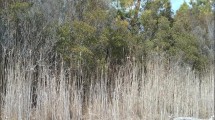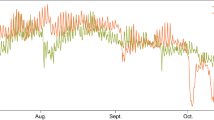Abstract
Coastal ecosystems lie at the forefront of sea level rise. We posit that before the onset of actual inundation, sea level rise will influence the species composition of coastal hardwood hammocks and buttonwood (Conocarpus erectus L.) forests of the Everglades National Park based on tolerance to drought and salinity. Precipitation is the major water source in coastal hammocks and is stored in the soil vadose zone, but vadose water will diminish with the rising water table as a consequence of sea level rise, thereby subjecting plants to salt water stress. A model is used to demonstrate that the constraining effect of salinity on transpiration limits the distribution of freshwater-dependent communities. Field data collected in hardwood hammocks and coastal buttonwood forests over 11 years show that halophytes have replaced glycophytes. We establish that sea level rise threatens 21 rare coastal species in Everglades National Park and estimate the relative risk to each species using basic life history and population traits. We review salinity conditions in the estuarine region over 1999–2009 and associate wide variability in the extent of the annual seawater intrusion to variation in freshwater inflows and precipitation. We also examine species composition in coastal and inland hammocks in connection with distance from the coast, depth to water table, and groundwater salinity. Though this study focuses on coastal forests and rare species of South Florida, it has implications for coastal forests threatened by saltwater intrusion across the globe.
Similar content being viewed by others
References
Alexander TR (1974) Evidence of recent sea level rise derived from ecological studies on Key Largo, Florida. In: Gleason PJ (ed) Environments of South Florida: present and past. Miami Geological Society, Coral Gables, Florida, pp 219–222
Allison I, Bindoff NL, Bindschadler RA et al (2009) Updating the world on the latest climate science. The University of New South Wales Climate Change Research Centre, Sydney
Armas C, Padilla FM, Pugnaire FI Jackson RB (2010) Hydraulic lift and tolerance to salinity of semiarid species: consequences for species interactions. Oecologia 162:11–21
Armentano TV, Jones DT, Ross MS, Gamble B (2002) Vegetation pattern and process in tree islands of the southern Everglades and adjacent areas. In: Sklar FJ, Valk FG (eds) Tree islands of the everglades. Kluwer, Dordrecht, pp 225–282
Barry M (2009) Data summary of working vegetation maps of the ten thousand islands national wildlife refuge. Report submitted to U.S. Department of the Interior Fish and Wildlife Service, Naples, Florida
Blasco F (1977) Outlines of ecology, botany and forestry of the Mangals of the Indian subcontinent. In Chapman VJ (ed) Wet coastal ecosystems. Ecosystems of the World Series. Elsevier, Amsterdam, pp 241–259
Blum MD, Roberts HH (2009) Drowning of the Mississippi delta due to insufficient sediment supply and global sea-level rise. Nat Geosci 2:488–491
Craighead FC (1964) Land, mangroves and hurricanes. Fairchild Trop Gard Bull 19:5–32
Craighead FC (1971) Trees of South Florida, volume I: the natural environments and their succession. University of Miami Press, Coral Gables
Diaz AP, Mannion C, Schaffer B (2006) Effect of root feeding by Diarepes abbreviatus (Coleoptera: Curulionidae) larvae on leaf gas exchange and growth of three ornamental tree species. J Econ Entomol 99:811–821
Donnelly JP, Bertress MD (2001) Rapid shoreward encroachment of salt marsh cordgrass in response to accelerated sea-level rise. PNAS 98:14218–14223
Ewe S (2001) Ecophysiology of Schinus terebinthifolius contrasted with native species in two South Florida ecosystems. Dissertation, University of Miami
DeSantis LR, Bhotika SK, Williams K et al (2007) Sea-level rise and drought interactions accelerate declines of coastal forests on the Gulf Coast of Florida, USA. Glob Chang Biol 13:2349–2360
Doyle TW, Krauss KW, Conner WH, From AS (2010) Predicting the retreat and migration of tidal forests along the northern Gulf of Mexico under sea-level rise. For Ecol Manag 259:770–777
Fitterman DV, Deszcz-Pan M, Stoddard CE (1999) Results of time-domain electromagnetic soundings in Everglades National Park, Florida (on CD-ROM). U.S. Geological Survey Open-File Report, pp 99–426
Freville H, McConway K, Dodd M, Silvertown J (2007) Prediction of extinction in plants: interaction of extrinsic threats and life history traits. Ecol 88:2662–2672
Gann GD, Bradley KA, Woodmansee SW (2002) Rare plants of South Florida: their history, conservation and restoration. The Institute for Regional Conservation, Miami
Gann GD, Bradley KA, Woodmansee SW et al (2008) Floristic inventory of the Florida Keys database online http://regionalconservation.org/ircs/database/DatabaseFK.asp. Accessed 10 April 2010
Gann GD, Bradley KA, Woodmansee SW (2010) Floristic inventory of South Florida database online http://regionalconservation.org/ircs/database/database.asp. Accessed 23 September 2010
Glenn EP, Brown JJ, Blumwald E (1999) Salt tolerance and crop potential of halophytes. Crit Rev Plant Sci 18:227–255
Gunderson LH (1994) Vegetation of the Everglades: determinants of community composition. In Davis SM, Ogden JC (eds) Everglades: the ecosystem and its restoration. St. Lucie, Delray Beach, pp 232–340
Holmes CW, Robbins J, Halley R et al (2000) Sediment dynamics of Florida Bay mud banks on a decadal time scale. In: Eggleston (ed) US geological survey program on the South Florida ecosystem. Proceedings of the greater everglades ecosystem restoration (GEER) conference. US Geological Survey Open-File Report 00-449
Ish-Shalom N, Sternberg LDL, Ross M et al (1992) Water utilization of tropical hardwood hammocks of the lower Florida Keys. Oecologia 92:108–112
Knighton AD, Mills K, Woodroffe CD (1991) Tidal-creek extension and saltwater intrusion in northern Australia. Geol 19:831–834
Klein H, Waller BG (1985) Synopsis of saltwater intrusion in Dade County, Florida, through 1984. U.S. Geological Survey, Water Resources Investigation Report 85–410
Krauss KW, Duberstein JA, Doyle TW et al. (2009) Site condition, structure, and growth of bald cypress along tidal/non-tidal salinity gradients. Wetland J 29:505–519
Kruse SE, Schneider JC, Inman JA et al (2000) Ground penetrating radar imaging of the freshwater/saltwater interface on a carbonate island, Key Largo, Florida. In: Noon DA, Stickley GF, Longstaff D (eds) Proceedings of the eighth international conference on ground penetrating radar. University of Queensland, Queensland, pp 335–340
Langevin CD, Stewart MT, Beaudoin CM (1998) Effects of sea water canals on fresh water resources: an example from big Pine Key, Florida. Ground Water 36:503–513
Langevin CD, Swain E, Wolfert M (2005) Simulation of integrated surface-water/ground-water flow and salinity for a coastal wetland and adjacent estuary. J Hydrol 314:212–224
Lucas RM, Ellison JC, Mitchell A et al (2002) Use of stereo aerial photography for quantifying changes in the extent and height of mangroves in tropical Australia. Wetl Ecol Manage 10:159–173
Maschinski J, Goodman JL, Powell D (2009) Assessment of population status and causes of decline for pilosocereus robinii (Lem.) byles & G. D. Rowley in the Florida keys. Final report to U.S. fish and wildlife service, South Florida ecological services office, Vero Beach, FL
Meadows DG, Caballero JP, Kruse SE, Vacher HL (2004) Variation of salinity in brackish-water lenses of two Florida Keys. J Coast Res 20:386–400
Meeder JF, Ross MS, Telesnicki PL et al (1996) Vegetation analysis in the C-111/Taylor Slough basin. Document 1: the southeast saline Everglades revisited: a half century of coastal vegetation change. Florida International University, Southeast Environmental Research Program, Miami, p 62
Munns R (2002) Comparative physiology of salt and water stress. Plant Cell Environ 25:239–250
Nuttle WK, Fourqurean JW, Cosby BJ et al (2000) Influence of net freshwater supply on salinity in Florida Bay. Water Res 36:1805–1822
Olmsted IC, Loope LL (1980) Vegetation along a microtopographic gradient in the estuarine region of Everglades National Park, Florida. Unpublished report submitted to South Florida Research Center, Homestead, Florida
Olmsted IC, Loope LL (1984) Plant communities of Everglades National Park. In: Gleason PJ (ed) Environments of South Florida: present and past II. Miami Geological Society, Coral Gables, pp 167–184
Olmsted IC, Loope LL, Russell RP (1981) Vegetation of the southern coastal region of the Everglades National Park between Flamingo and Joe Bay. South Florida Research Center Homestead, Florida, Technical Report T-620
Pearlstine LG, Pearlstine EV, Sadle J et al (2009) Potential ecological consequences of climate change in south Florida and the Everglades: 2008 literature synthesis. Technical Series 2009. South Florida Natural Resources Center, Homestead, Florida, pp 1–35
Perry L, Williams W (1996) Effects of salinity and flooding on seedlings of cabbage palm (Sabal palmetto). Oecologia 105:428–434
Pielou EC (1960) A single mechanism to account for regular, random and aggregated populations. J Ecol 48:575–584
Price RM, Top Z, Happell JD, Swart PK (2003) Use of tritium and helium to define groundwater flow conditions in Everglades National Park. Water Resour Res 39(9):1267. doi:10.1029/2002WR001929
Price RM, Swart PK, Fourqurean JW (2006) Terrestrial brackish groundwater discharge—a significant source of phosphorus for the oligotrophic wetlands of the Everglades. Hydrobiol 569:23–36
Reed DJ (2002) Sea-level rise and coastal marsh sustainability: geological and ecological factors in the Mississippi delta plain. Geomorphol 48:233–243
Ross MS, O’brien JJ, Flynn LJ (1992) Ecological site classification for Florida Keys terrestrial habitats. Biotropica 24:488–502
Ross MS, Obrien JJ, Sternberg LDL (1994) Sea-level rise and the reduction in pine forests in the Florida Keys. Ecol Appl 4:144–156
Ross MS, O’Brien JJ, Ford RG et al (2009) Disturbance and the rising tide: the challenge of biodiversity management for low island ecosystems. Front Ecol Environ 9:471–478
Saha AK (2009) The role of spatiotemporal heterogeniety in water and nutrient pools in Everglades plant community diversity and function. Dissertation, University of Miami, Coral Gables
Saha AK, Sternberg LS, Miralles-Wilhelm F (2009) Linking water sources with foliar nutrient status in upland plant communities in the Everglades National Park, USA. Ecohydrol 1:42–54
Schwadron M (2010) Landscapes of maritime complexity: prehistoric shell work sites of the Ten Thousand Islands, Florida. Dissertation, University of Leicester, Leicester
Sklar F, Browder J (1998) Coastal environmental impacts brought about by alteration of freshwater flow into the Gulf of Mexico. J Environ Manag 22:547–562
Small JK (1927) Among floral aborigines: a record of exploration in Florida in the winter of 1922. J New York Bot Garden 28:1–20
Sonenshein RS, Koszalka EJ (1996) Trends in water table altitude (1984–93) and saltwater intrusion (1974–93) in the Biscayne aquifer, Dade County, Florida: 2 sheets. U.S. Geological Survey Open-File Report 95-705
Stalter R, Kincaid D (2004) The vascular flora of five Florida shell middens. J Torrey Bot Soc 131:93–103
Sternberg LDL, Swart PK (1987) Utilization of freshwater and ocean water by coastal plants of Southern Florida. Ecology 68:1898–1905
Sternberg LDL, Teh SY, Ewe S et al (2007) Competition between hardwood hammocks and mangroves. Ecosystem 10:648–660
Sullivan P, Price R, Ross M et al (2010) Hydrologic processes of tree islands in the Everglades: tracking the effects of tree establishment and growth. Hydrogeol J. doi:10.1007/s10010-010-0691-0. doi:10.1007/s10040-010-0691-0
Teh SY, DeAngelis DL, Sternberg L et al (2008) A simulation model for projecting changes in salinity concentrations and species dominance in the coastal margin habitats of the Everglades. Ecol Model 213:245–256
Tomlinson PB (1980) The biology of trees native to tropical Florida. Harvard University Press, Alston
Urrego LE, Polania J, Buitrago MF et al (2009) Distribution of mangroves along environmental gradients on San Andres Island (Colombian Caribbean). Bull Mar Sci 85:27–43
U.S. Department of the Interior (2007) http://sofia.usgs.gov/publications/ofr/02-101/data.html. U.S. Geological Survey. Accessed 1 October 2010
Villalobos R (2010) Water table and nutrient dynamics in neotropical savannas and wetland ecosystems. Dissertation, University of Miami
Wanless HR, Parkinson RW, Tedesco LP (1994) Sea level control on stability of Everglades wetlands. In: Davis SM, Davis Ogden JC (eds) Everglades: the ecosystem and its restoration. St. Lucie, Boca Raton, pp 198–224
Williams K, Ewel KC, Stumpf RP et al (1999) Sea-level rise and coastal forest retreat on the west coast of Florida, USA. Ecology 80:2045–2063
Williams K, MacDonald M, McPherson K et al (2007) Ecology of the coastal edge of hydric hammocks on the gulf coast of Florida. In: Conner WH, Doyle TW, Krauss K (eds) Ecology of tidal freshwater forested wetlands of the southeastern United States. Springer, Netherlands, pp 255–289
Author information
Authors and Affiliations
Corresponding author
Rights and permissions
About this article
Cite this article
Saha, A.K., Saha, S., Sadle, J. et al. Sea level rise and South Florida coastal forests. Climatic Change 107, 81–108 (2011). https://doi.org/10.1007/s10584-011-0082-0
Received:
Accepted:
Published:
Issue Date:
DOI: https://doi.org/10.1007/s10584-011-0082-0




